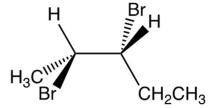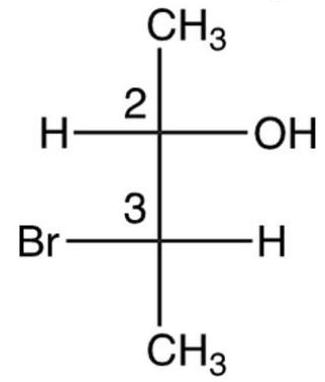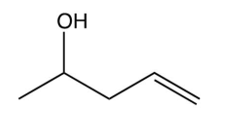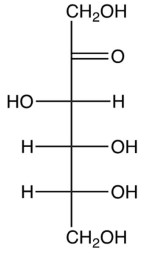Deck 7: Chirality
Question
Question
Question
Question
Question
Question
Question
Question
Question
Question
Question
Question

Unlock Deck
Sign up to unlock the cards in this deck!
Unlock Deck
Unlock Deck
1/12
Play
Full screen (f)
Deck 7: Chirality
1
Which of the following molecules are chiral?

A) only II
B) only III
C) II and III
D) I, II, and III

A) only II
B) only III
C) II and III
D) I, II, and III
only II
2
How many stereogenic centers are there in the following molecule?

A) only 1
B) two
C) three
D) four

A) only 1
B) two
C) three
D) four
two
3
What is the IUPAC name of the following compound?

A) (2S, 3S)-2,3-dibromopentane
B) (2S, 3R)-2,3-dibromopentane
C) (2R, 3S)-2,3-dibromopentane
D) (2R, 3R)-2,3-dibromopentane

A) (2S, 3S)-2,3-dibromopentane
B) (2S, 3R)-2,3-dibromopentane
C) (2R, 3S)-2,3-dibromopentane
D) (2R, 3R)-2,3-dibromopentane
(2R, 3R)-2,3-dibromopentane
4
What is the relationship between the following two molecules?

A) identical
B) enantiomers
C) diastereomers
D) constitutional isomers

A) identical
B) enantiomers
C) diastereomers
D) constitutional isomers

Unlock Deck
Unlock for access to all 12 flashcards in this deck.
Unlock Deck
k this deck
5
What are the configurations of carbons 2 and 3 in the Fischer projection below?

A) 2R, 3R
B)
C) 2S, 3R
D) 2S, 3S

A) 2R, 3R
B)
C) 2S, 3R
D) 2S, 3S

Unlock Deck
Unlock for access to all 12 flashcards in this deck.
Unlock Deck
k this deck
6
Compound , is optically active. The compound consumes one equivalent of hydrogen to give . The hydrogenation product is also optically active. Which compound below matches the information?
A)

B)

C)

D)

A)

B)

C)

D)


Unlock Deck
Unlock for access to all 12 flashcards in this deck.
Unlock Deck
k this deck
7
A pure sample of (S)-phenylalanine has a specific rotation of . A mixture of the two enantiomers of phenylalanine has a specific rotation of . What are the percentages of the and enantiomers in the mixture?
A)
B)
C)
D)
A)
B)
C)
D)

Unlock Deck
Unlock for access to all 12 flashcards in this deck.
Unlock Deck
k this deck
8
Which of the following has a meso stereoisomer?
I. 2,4-dichloropentane
II. 1,3-dimethylcyclopentane
III. 2,3-dichloropentane
A) only I
B) only II
C) I and III
D) I and II
I. 2,4-dichloropentane
II. 1,3-dimethylcyclopentane
III. 2,3-dichloropentane
A) only I
B) only II
C) I and III
D) I and II

Unlock Deck
Unlock for access to all 12 flashcards in this deck.
Unlock Deck
k this deck
9
How many stereoisomers are there of D-fructose (including D-fructose), shown below?

A) four
B) six
C) eight
D) twelve

A) four
B) six
C) eight
D) twelve

Unlock Deck
Unlock for access to all 12 flashcards in this deck.
Unlock Deck
k this deck
10
Which compound below has no stereoisomers?
A) 1,2-dichlorobutane
B) 1,3-dichlorobutane
C) 2,3-dichlorobutane
D) 1,4-dichlorobutane
A) 1,2-dichlorobutane
B) 1,3-dichlorobutane
C) 2,3-dichlorobutane
D) 1,4-dichlorobutane

Unlock Deck
Unlock for access to all 12 flashcards in this deck.
Unlock Deck
k this deck
11
Which one of the following is a diastereomer of (2R,3R)-2,3-dibromopentane?
A) (2S,3S)-2,3-dibromopentane
B) (2S,3R)-2,3-dibromopentane
C) R-1,2-dibromopentane
D) (2R,4R)-2,4-dibromopentane
A) (2S,3S)-2,3-dibromopentane
B) (2S,3R)-2,3-dibromopentane
C) R-1,2-dibromopentane
D) (2R,4R)-2,4-dibromopentane

Unlock Deck
Unlock for access to all 12 flashcards in this deck.
Unlock Deck
k this deck
12
The tartaric acid found in fruits, when isolated, exhibits . Which configuration is NOT possible for this naturally-occurring material?
![<strong>The tartaric acid found in fruits, when isolated, exhibits [\alpha]=+12^{\circ} . Which configuration is NOT possible for this naturally-occurring material? </strong> A) R, R B) R, S C) S, S D) there is no way to tell](https://d2lvgg3v3hfg70.cloudfront.net/TB10580/11eeda09_28b8_4609_87de_4d6ea7aa43b1_TB10580_00.jpg)
A) R, R
B) R, S
C) S, S
D) there is no way to tell
![<strong>The tartaric acid found in fruits, when isolated, exhibits [\alpha]=+12^{\circ} . Which configuration is NOT possible for this naturally-occurring material? </strong> A) R, R B) R, S C) S, S D) there is no way to tell](https://d2lvgg3v3hfg70.cloudfront.net/TB10580/11eeda09_28b8_4609_87de_4d6ea7aa43b1_TB10580_00.jpg)
A) R, R
B) R, S
C) S, S
D) there is no way to tell

Unlock Deck
Unlock for access to all 12 flashcards in this deck.
Unlock Deck
k this deck



